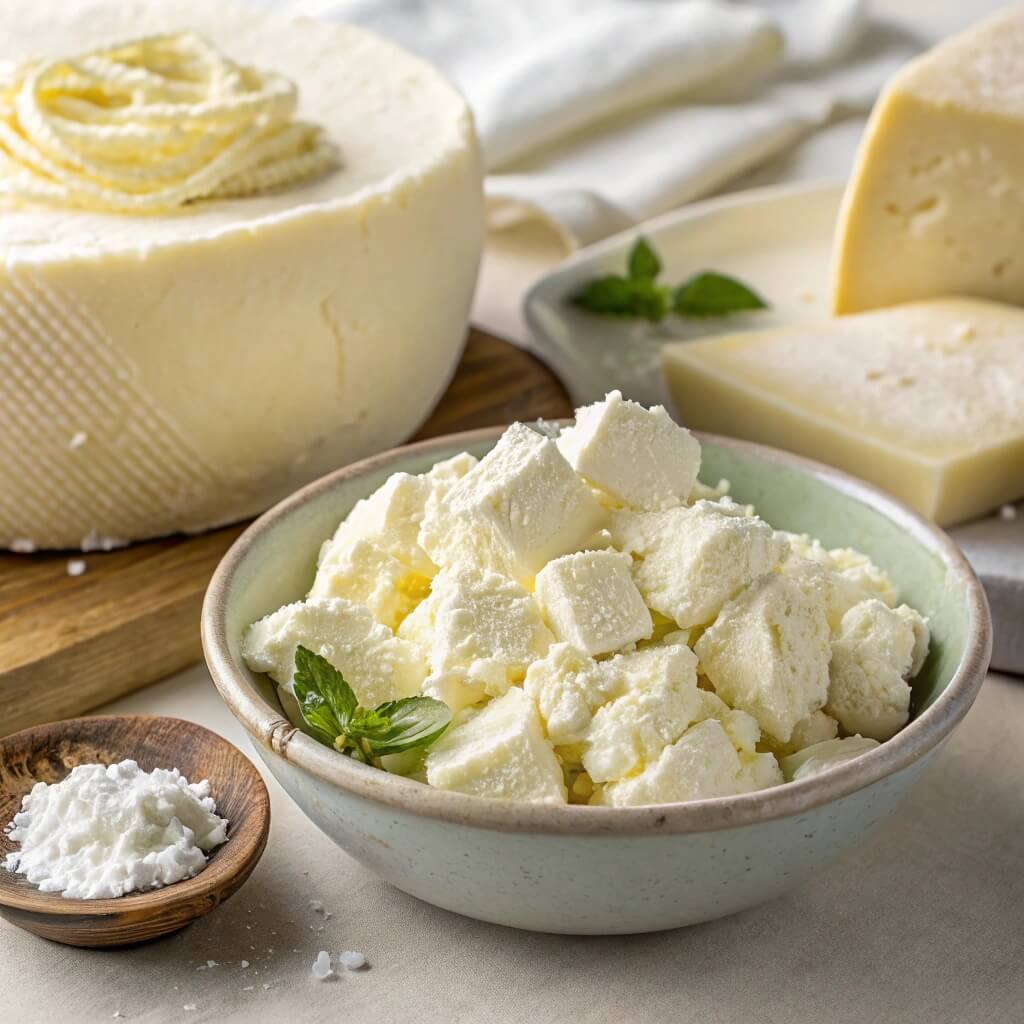Last Sunday, I spent three hours in my kitchen testing different ricotta brands for my lemon pasta recipe. Trust me when I say this: the ricotta you choose can transform your pasta from “meh” to “wow!” After years of pasta-making (and plenty of ricotta disasters), I’ve learned a thing or two about picking the right cheese for the job.
What Makes Ricotta Work in Pasta?
Excellent pasta-friendly ricotta boils down to a few key things:
Texture matters enormously! Too lumpy? Your sauce feels grainy. Too wet? Hello, watery pasta puddle. The sweet spot is creamy yet slightly structured ricotta that melts into your hot pasta without disappearing entirely.
Fat content is another game-changer. My grandma always scolded me for buying low-fat ricotta. “Why ruin good pasta to save two grams of fat?” she’d ask. She wasn’t wrong—whole milk ricotta creates silky, rich sauces that cling beautifully to pasta.
Then there’s freshness. Ricotta sitting in your fridge for two weeks won’t do your pasta any favors. Fresh ricotta tastes subtly sweet with bright dairy notes that complement pasta perfectly.
The Homemade vs. Store-Bought Debate: ricotta cheese for pasta dishes
Why I Started Making My Own
Store-bought ricotta had disappointed me one too many times, which pushed me into making homemade ricotta. Here’s what converted me:
The taste difference shocked me. Homemade ricotta tastes alive—milky, fresh, and clean. Most supermarket versions can’t compare.
I’m somewhat ingredient-obsessed, and making ricotta lets me control everything. I can choose local milk, adjust salt levels, and decide exactly how dry or wet I want it.
Plus, the texture is customizable. For my lemon spaghetti, I drain it for just 45 minutes for a creamy consistency. For stuffed shells, I let it sit for a more extended period—about 2 hours—to achieve a sturdier texture.
My Fool-Proof Kitchen Counter Ricotta
You don’t need fancy equipment to make ricotta. Here’s my no-fail method:
Pour a gallon of whole milk into your biggest pot. Heat it slowly to 185°F (or until steamy but not boiling). If you don’t have a thermometer, watch for tiny bubbles around the edge.
Remove it from the heat and pour in 1/4 cup of fresh lemon juice or white vinegar, then stir gently just twice. Now—and this is important—walk away! Let it sit undisturbed for 10 minutes while the magic happens.
You’ll see the milk separating into curds and watery whey. Line a colander with a clean kitchen towel or cheesecloth, place it over a bowl, and slowly pour in your curd mixture.
The draining time determines your ricotta’s personality. Thirty minutes gives you wet, creamy cheese perfect for pasta sauces. Two hours creates firmer ricotta ideal for stuffed pasta. I’ve accidentally left it overnight and ended up with something closer to farmer’s cheese—still delicious, but too dry for most pasta dishes.
When Reality Hits: Buying Smart
Look, sometimes life gets crazy busy. On those days when homemade ricotta isn’t happening, I have a strategy for store-bought:
First, flip that container over and read the ingredients. If it lists more than milk, salt, and maybe citric acid or enzymes, put it back. Those stabilizers and gums might extend the shelf life, but they alter the texture of pasta dishes.
Check the container’s bottom and sides for excessive liquid—never a good sign. Slight wetness is normal, but a puddle means trouble.
Most grocery stores carry at least three to four brands. I’ve learned the hard way that price often (but not always) reflects quality with ricotta. That $1.50 tub might be tempting, but spending a few dollars more often makes a huge difference in your final pasta dish.
Matching Ricotta Types to Pasta Styles
For Silky Sauces Like Lemon Ricotta Linguine
My weekend favorite is a simple lemon ricotta pasta that demands fresh, high-moisture ricotta. The cheese should feel luxuriously smooth and almost melt into the hot pasta, creating a velvety sauce that coats each strand.
Last month, I tried using leftover stuffing ricotta for this dish—big mistake! The drier cheese was never fully incorporated, leaving little lumps throughout. Lesson learned: for creamy sauces, freshness and moisture are non-negotiable.
For Stuffed Treasures Like Ravioli
Stuffed pasta needs ricotta with backbone. Too wet, and you’ll have soggy pasta that bursts during cooking. I learned this the hard way after an epic ravioli disaster that left me with a pot of floating pasta fragments.
The ricotta should hold its shape when scooped and feel relatively firm. If it’s sliding off your spoon like yogurt, either drain it for an hour or two yourself or choose a different brand.
For Hearty Baked Dishes
Lasagna and baked ziti need ricotta that can withstand heat without separating. Medium-moisture, whole-milk ricotta works beautifully here. It should maintain some texture during baking while still contributing a creamy consistency.
My aunt makes incredible baked pasta, and her secret is working a beaten egg into the ricotta before layering. This helps maintain structure while keeping the ingredients moist throughout the baking process.
Real Talk About Store Brands
After countless pasta nights, I’ve developed strong opinions about supermarket ricotta:
Calabro ricotta changed my store-bought perspective. It’s almost suspiciously good for commercial ricotta—creamy, clean-tasting, and perfectly textured for pasta. Worth seeking out at specialty stores or well-stocked supermarkets.
BelGioioso makes solid ricotta that’s widely available. Their fresh version (usually in a black container) outperforms their standard offering by a long shot. It makes lovely creamy pasta sauces with minimal effort.
Galbani seems to be everywhere, but I find it inconsistent. Sometimes it’s perfect; other times, strangely watery. If I use it, I usually drain it for 30 minutes before adding it to pasta.
Store brands vary wildly. My local co-op’s house brand ricotta beats national brands, while the budget option at the chain grocery makes disappointingly grainy pasta sauce.
Rescuing Less-Than-Perfect ricotta cheese for pasta dishes
Sometimes you’re stuck with sub-par ricotta. Here’s how to save your pasta:
Too wet ricotta gets an easy fix: dump it into a fine-mesh strainer lined with paper towels and let gravity work its magic for an hour or longer in the fridge.
Dry, crumbly ricotta needs moisture. I fold in a splash of heavy cream or even full-fat plain yogurt until it reaches a creamier state.
Bland ricotta is often a problem with mass-produced brands. Adding freshly grated lemon zest, a pinch of good salt, or some chopped herbs can dramatically enhance the flavor. My secret weapon? A tiny drizzle of excellent olive oil mixed in.
For grainy texture—my pasta pet peeve—vigorous beating with a wooden spoon sometimes helps. For stubborn cases, I break out the food processor and pulse until smooth, or press it through a fine-mesh sieve with the back of a spoon.
Hidden Gems Worth Hunting Down
If you’re ready to take your pasta to new heights, seek out these specialty ricottas:
Sheep’s milk ricotta changed my pasta world. It’s richer than cow’s milk ricotta with a subtle tanginess that pairs wonderfully with lemon, herbs, or pepper in pasta dishes. Expensive but transformative.
Once a year, our farmers’ market features a vendor with buffalo milk ricotta. Its extravagant creaminess makes an unforgettable pasta sauce, though at a price that keeps it in “special occasion” territory.
Traditional basket-drained ricotta has a distinctive texture that commercial container-set ricotta can’t match. If you spot it at an Italian specialty shop, grab it for your next pasta night.
Storing Your Precious Cheese
Nothing ruins pasta night like spoiled ricotta. For optimal freshness:
Keep unopened ricotta in its original container until you need it. Once opened, I transfer the leftovers to a glass container with a tight-fitting lid, which seems to preserve freshness better than plastic containers.
Fresh ricotta has a criminally short lifespan. Use it within 4-5 days for optimal flavor, although commercially produced varieties with preservatives may last a bit longer.
And please, don’t freeze ricotta destined for pasta sauce! I tried this shortcut once and ended up with weirdly grainy, separated cheese that ruined my carefully crafted pasta dish. Some cooking lessons come the hard way.
Parting Thoughts: ricotta cheese for pasta dishes
Through countless pasta dinners—both triumphant and disastrous—I’ve found that ricotta selection isn’t just a minor detail but a make-or-break decision. Whether making a quick weeknight lemon ricotta spaghetti or a weekend ravioli project, the right cheese makes all the difference.
Starting with good ricotta means you’ll need fewer ingredients and less fussing to create remarkable pasta. And isn’t that the beauty of Italian cooking? Quality ingredients, treated, creating something greater than the sum of their parts.
What’s your go-to ricotta for pasta? Have you found a supermarket brand that outperforms the rest? Or are you ready to try making your own this weekend? Drop me a comment—I’m always collecting ricotta wisdom!
This post was updated after my recent ricotta tasting party, where we sampled eight different brands of ricotta. My pasta-loving friends still haven’t forgiven me for the massive carb load, but in the name of research, sacrifices must be made!











